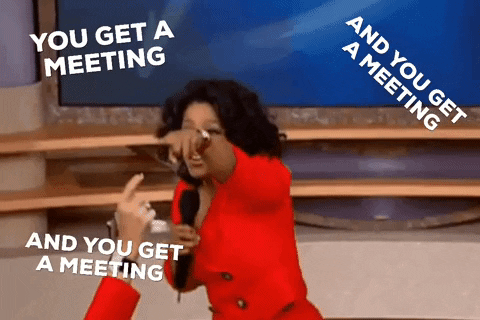It’s time for an intervention.
Ding! A new notification comes in that invites me to a new meeting. Dread fills my stomach about hitting accept. I hover over the decline button for a brief moment. Do I dare?
I give in and click accept. I’m weak.
As a remote employee, meetings are a way for me to get face time and build connections. Otherwise, I’m in my living room in PJs wondering if everyone is having fun in the office without me. FOMO.
But that’s not the purpose of meetings. Or, at least not every meeting.
The data is wild:
- On average, 18 hours a week are spent in meetings
- Noncritical meetings waste about $25,000 dollars
- Employees don’t need to be in ⅓ of the meetings they attend
- Women are less likely to decline meetings then men (UGH!)
Not to mention, poorly run meetings are harmful for employee engagement and retention.
Sooo meetings waste time AND money but we’re all still agreeing to attend them? Cool cool.
Why do we go to meetings?

The next time you’re in a meeting on Friday at 5PM you can thank the Ancient Greeks! They invented the concept of meetings and throughout history there have been several forms of the meeting. The rise of office buildings in the 20th century cemented the role of meetings in our workplaces.
Large offices were built with meetings in mind usually featuring a large board room for groups to gather around tables. But the pivot to remote work changed everything… there are no big round tables for us to gather around in the remote world.
The pivot to remote work has taught us a lot about our working habits. Some things I’d prefer to not have learned but here we are!
In a remote world, meetings have become our default because:
- Managers don’t know how to manage work and/or people without requiring meetings
- Employees feel the only face time they can get is through meetings (been there!)
- Tone is impossible to convey via written communication so most folks opt for meetings to avoid miscommunications
Despite the data showing:
- 92% of employees state meetings are costly and unproductive
- 70% of meetings keep employees from doing their work
- Zoom fatigue leads to stress
- Upper management spends about 50% of their time in meetings
Maybe think twice before hitting send on that calendar invite…
What type of meetings should we be having?

I’m not going to suggest we stop having meetings. I’m going to suggest we become more intentional and selective about our meetings.
Easier said than done, I know!
JOIN 130K+ HR LEADERS
Get insights, learnings, and advice on how to build companies and cultures that people actually love.
No spam. Unsubscribe any time.
When it comes to meetings there is no one size fits all. There are certain meetings that are better for certain goals.
3 types of meetings:
1. Strategic: The goal of these meetings is to focus on strategic initiatives and how to allocate resources properly to enable execution.
PSA: Your team cannot execute if there is no strategy laid out.
Lots of folks get this type of meeting wrong. Here is a resource to help you effectively facilitate a strategy meeting.
Spoiler alert: Group size matters! The ideal group size for innovative work is 4 to 6 people. Yup, you read that right! Smaller groups will allow for more productivity and less cognitive overload.
2. Relationship building: The goals of these types of meetings are to build connections and strengthen relationships like 1:1s, coaching conversations, team building, etc!
These types of meetings are especially crucial during onboarding when new employees are desperate to build connections in a new workplace.
Don’t overlook the power of building relationships.
3. Tactical: The goal of these types of meetings are to focus on a task and how to move it forward. These meetings feature discussions around roadblocks, status updates and day to day tasks.
Here is guide on how to run tactical meetings.
Look at your calendar. Do you know which category each meeting falls into? If not, it might be a sign that the meeting isn’t needed or more clarity is needed. Every meeting should have a goal. If you are just meeting to meet you’re wasting time. And time is a currency. Cha-ching.
If you’re a manager – encourage your team to approach meetings with the same mindset!
What HR/People teams can do about meetings:

The cadence of meetings, chats, and emails have only gone up in the pandemic! Yikes. Poorly run meetings negatively impact engagement, retainment and productivity. Double yikes.
HR/People teams it’s time to intervene…
3 tips for how to manage meeting overload:
1. Conduct an audit: How is your organization spending their time? Are certain teams spending more time than others in meetings? If your engineering team is spending the majority of their time in meetings how will they ever build your product? (They won’t)
If your organization is using Google calendar, send your teams Workweek Unwrapped and ask folks to share their results!
2. Require agendas. Make agendas a must for every meeting your organization holds! Why? An agenda:
- Forces the organizer to know the purpose
- Sets expectations for attendees accordingly
- Sets goals for what to achieve
Something helpful to consider: Ask your employees to start classifying their meetings and using that classification type as part of the meeting title. For example: Strategic Meeting: Company Goals.
By making it clear to attendees what type of meeting they are taking part in they will be better prepared, able to effectively contribute or decline as not needed.
3. Empower your employees to decline. Yes, you should encourage leadership/managers to stop with the excessive meetings. You should also encourage your employees to decline meetings.
Pro-tip: Make it a 2023 company goal to have less meetings. Give your employees the framework of what types of meetings to be having then empower them to decline. I promise you, you’ll see a change in 6 months.
Final reminder: meetings cost your organization $$. If companies are trying to save money in 2023 to outlive a recession maybe they should consider looking at their meeting strategy.
What I learned from my Workweek Unwrapped:

Curious what your calendar says about you? Do your Workweek Unwrapped and if you want to be brave post your calendar stats on Linkedin. I dare you.


